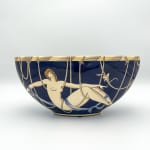Gio Ponti
Leonia, (hand painted bowl decorated with woman and ropes)
Ceramic, manufactured 2010, designed earlier
height 6 x width 13 x depth 7 in
height 15.2 x width 33 x depth 17.8 cm
height 15.2 x width 33 x depth 17.8 cm
Marked 'Richard Ginori 1735 Made in Italy' and artist's signature, title 'Leonia', inscribed and numbered 'Dipinto a Nano MF Serie numerata No 7' engobe on base
Copyright The Artist
$ 10,500.00
Further images
A pair of bowls, so very Art Deco, so very Italian, so much so Gio Ponti. . Gio Ponti was born in Milan in 1891. He started as a designer...
A pair of bowls, so very Art Deco, so very Italian, so much so Gio Ponti.
.
Gio Ponti was born in Milan in 1891. He started as a designer and an architect, and later gained the trust of Augusto Richard who in 1923 appointed Ponti as artistic director of Richard-Ginori, a renowned ceramic factory with locations in Milan and Doccia. At the first Biennale of Decorative Arts in Monza it was Ponti’s name on most of the newest designs presented by Richard-Ginori. For the Paris Expo in 1925, Ponti created the designs for these elegant depictions seen above. Perhaps historically fraught and yet empowered and playful titillating nude figures of tantalizing yet traditional imagery and an excellent example of Italian design matched with historical lore helped to define an era of Art Deco and beyond.
.
‘My Women, Donatella’ and ‘My Women, Leonia’ are hand painted majolica shaped in mould and decorated with underglaze polychrome enamels each bowl reaches approximately 6” x 13” and are marked with maker’s stamp and the artist’s signature with series number on the base manufactured in 2010 from the original design at Richard-Ginori. Ponti’s role in Italian ceramics and design are pervasive, showing up in nearly every avenue of its vivid history. Ponti’s accomplishments move far beyond his work in ceramics, and his design work is profoundly felt in the history of fine art. He died in 1979.
.
Regarding how the modern exhibition was considered: “…It contains everything; the true and the false, the real and the fictitious, in arbitrary and accidental proportions.” - Gio Ponti, (Paris Expo of 1925)
.
Gio Ponti was born in Milan in 1891. He started as a designer and an architect, and later gained the trust of Augusto Richard who in 1923 appointed Ponti as artistic director of Richard-Ginori, a renowned ceramic factory with locations in Milan and Doccia. At the first Biennale of Decorative Arts in Monza it was Ponti’s name on most of the newest designs presented by Richard-Ginori. For the Paris Expo in 1925, Ponti created the designs for these elegant depictions seen above. Perhaps historically fraught and yet empowered and playful titillating nude figures of tantalizing yet traditional imagery and an excellent example of Italian design matched with historical lore helped to define an era of Art Deco and beyond.
.
‘My Women, Donatella’ and ‘My Women, Leonia’ are hand painted majolica shaped in mould and decorated with underglaze polychrome enamels each bowl reaches approximately 6” x 13” and are marked with maker’s stamp and the artist’s signature with series number on the base manufactured in 2010 from the original design at Richard-Ginori. Ponti’s role in Italian ceramics and design are pervasive, showing up in nearly every avenue of its vivid history. Ponti’s accomplishments move far beyond his work in ceramics, and his design work is profoundly felt in the history of fine art. He died in 1979.
.
Regarding how the modern exhibition was considered: “…It contains everything; the true and the false, the real and the fictitious, in arbitrary and accidental proportions.” - Gio Ponti, (Paris Expo of 1925)
Join our mailing list
* denotes required fields
We will process the personal data you have supplied in accordance with our privacy policy (available on request). You can unsubscribe or change your preferences at any time by clicking the link in our emails.





